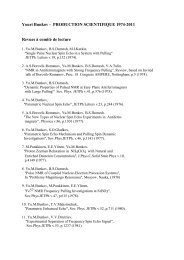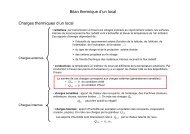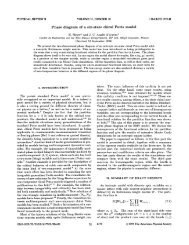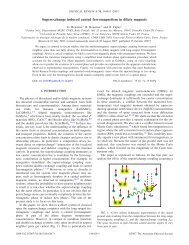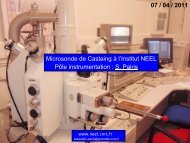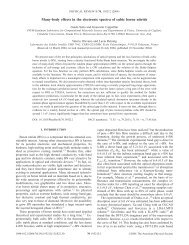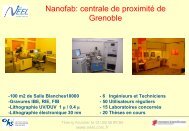Activity Report 2010 - CNRS
Activity Report 2010 - CNRS
Activity Report 2010 - CNRS
Create successful ePaper yourself
Turn your PDF publications into a flip-book with our unique Google optimized e-Paper software.
HIGHLIGHT : NANOMATERIALS, NANOASSEMBLY AND NANOSTRUCTURATION<br />
CONTACTS<br />
borsali@cermav.cnrs.fr<br />
FURTHER READING<br />
K. Aissou et al., Langmuir, 27 (7), pp 4098–<br />
4103 (2011)<br />
C. Porto et al., Macromolecules, 44 (7), pp<br />
2240–2244 (2011)<br />
NANOSTRUCTURED<br />
LIGHT-EMITTING SMALL<br />
MOLECULES VIA<br />
HYBRID NATURAL-<br />
BLOCK-SYNTHETIC<br />
SUPRAMOLECULAR<br />
ASSEMBLY<br />
Self-assembly is emerging as an elegant,<br />
'bottom-up' method for fabricating<br />
nanostructured materials. As current<br />
polymers derive from petroleum - a<br />
resource that is being rapidly depleted -<br />
oligo and polysaccharides constitute an<br />
abundant, renewable, and yet<br />
undervalued resource for the fabrication of<br />
bio-inspired nanoelectronic devices. Within<br />
the framework of the 2007 RTRA project<br />
called “CELLULOSE HYBRID”, 3<br />
laboratories (CERMAV, LTM and Léti) have<br />
conceived a new method to build a<br />
versatile hierarchical assembly of hybrid<br />
diblock copolymer (cellulose based<br />
material) which led to tunable-lightemitting<br />
films. (1 patent)<br />
Synthesis and self-assembly<br />
of glycopolymer-based<br />
copolymers in thin films<br />
First, the team designs a hybrid naturalblock-synthetic<br />
copolymer system where<br />
the synthetic block is polystyrene and the<br />
natural one is an amylose fragment:<br />
maltoheptaose (noted maltoheptaoseblock-polystyrene<br />
(Mal7-b-PS))<br />
TEM pictures of Mal7-b-PS copolymer thin<br />
film confirm its phase organization (Fig.<br />
1). They show a stripe pattern, with dark<br />
regions smaller than bright ones, caused<br />
by the orientation of MAL7 cylinders<br />
parallel to the film free surface.<br />
Fig. 1: TEM picture of Mal7-b-PS thin film<br />
showing a stripe pattern, with a lattice period of<br />
about 12 nm measured from FFT inset.<br />
Photoluminescence of lightemitting<br />
thin film<br />
For light-emitting applications, one<br />
important challenge is to fabricate thin<br />
films with an optimal structure i.e. having<br />
large interface area and domain size<br />
similar to the exciton diffusion length<br />
about 10 nm. It has been possible to<br />
fabricate supramolecular architecture with<br />
active 4’,4-bipyridine on maltoheptaose<br />
blocks which fits this requirement to get<br />
expected photonic properties.<br />
Photoluminescence (PL) data of<br />
Mal7(bipy) 1.0 -b-PS thin films deposited on<br />
SiO 2 substrate were recorded (Fig. 2) after<br />
different annealing times. It yields wellorganized<br />
films (48h annealing),<br />
exhibiting a three times higher PL signal<br />
compared to a poorly organized film (15<br />
min annealing).<br />
Fig. 2: Photoluminescence spectra (excitation at<br />
365 nm) of Mal7(bipy)1.0-b-PS thin film after<br />
15 min (red) and 48h (black) annealing time.<br />
F<br />
ig.3: AFM phase image obtained from<br />
Mal7(bipy)1.0-b-PS thin film. The phase crosssection<br />
profile of the continuous red line on the<br />
AFM phase image inset revealed a distance of<br />
11nm between two white spots.<br />
This innovative conception of organic<br />
light-emitting diodes (OLEDs) has been<br />
patented (French patent deposited in<br />
<strong>2010</strong>).<br />
9



